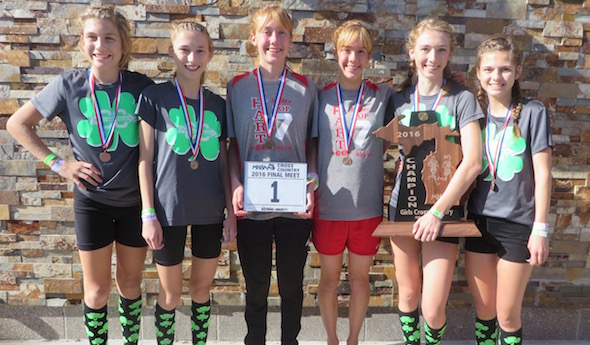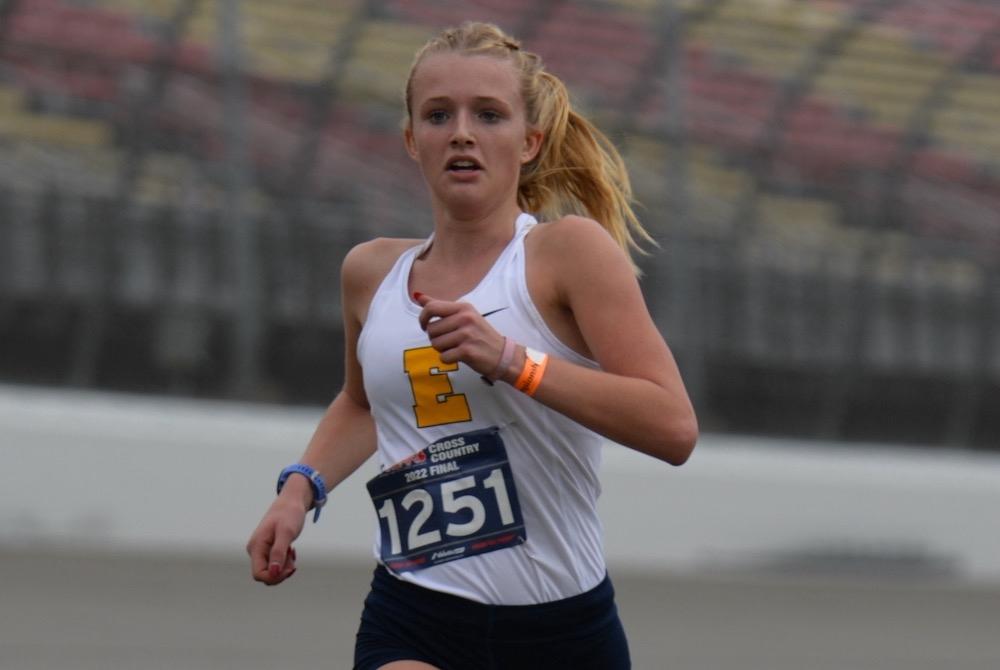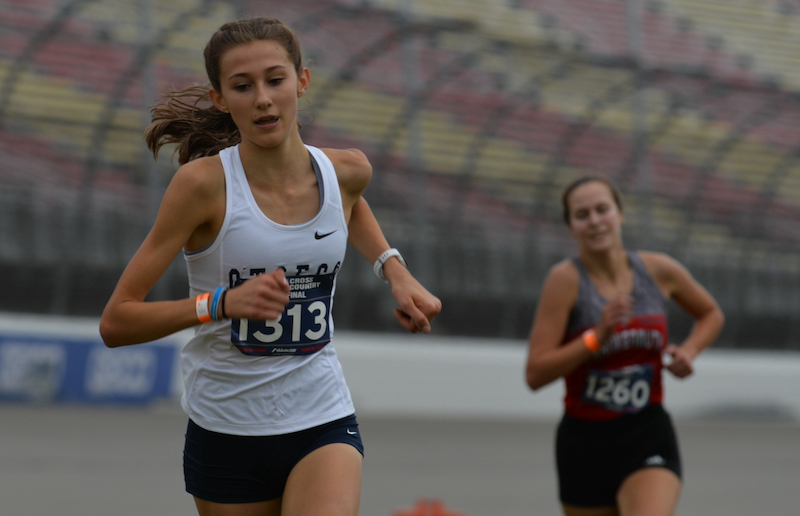
Friendship Binds Champion Sister Acts
By
Dennis Chase
Special for MHSAA.com
November 2, 2017
By Dennis Chase
Special for Second Half
TRAVERSE CITY – Former college teammates Calvin Ackley and Rob McConnell used to joke that if their seven “little girls” ever took up cross country, and ran on the same team one day, that maybe, just maybe, they could win an MHSAA Finals championship.
The one team theory did not happen.
The championships? Well, that’s another story.
Rob and Tori McConnell’s four daughters have played prominent roles in Mount Pleasant Sacred Heart’s recent dominance in Division 4. The top-ranked Irish are favorites to three-peat Saturday at the Lower Peninsula Finals at Michigan International Speedway.
Meanwhile, Calvin and Amy Ackley’s daughter, Adelyn, will be seeking to defend her Division 3 individual championship. Top-ranked Hart, led by three Ackley sisters, will attempt to win the school’s first MHSAA team championship in any sport.
So, in the end, it wasn’t one school that benefitted. It was two.
“The next best thing,” said Calvin Ackley.
Ackley and McConnell go back 25 years, They were the top two runners on the Cornerstone University cross country team in 1992-93. The two friends eventually went their separate ways, but then reconnected a few years later after they had married and started having children – girls, lots of girls.
The families started getting together a couple times a year.
“We like to visit during the summer,” said Bailley McConnell, a senior at Sacred Heart. “We’re all good friends. They’re like family.”
The girls like to be active when they’re together – going out for runs, playing on the sand dunes near Silver Lake, swimming, jumping around on a trampoline, and 4-wheeling.
“We’re pretty energetic when we’re together,” said Alayna Ackley, a senior at Hart. “We have a lot of fun.”
They’re having a lot of fun this fall, too.
And not just on the trails. The girls like to peruse athletic.net, a website filled with running results, to keep track of each other.
“We’re always looking to see how they’re doing and comparing it to how we’re doing,” said Bailley.
A little friendly competition of sorts.
“It’s like, ‘OK, the McConnells are doing this. We need to step it up,’” said Calvin.
Hart and Sacred Heart both have failed to finish first just once this season – in September’s all-division Spartan Elite race at Michigan State. Hart finished second, eight points behind Rockford, the state’s No. 1 team in Division 1.
The Ackley sisters own three of the top six times statewide in Division 3 – Adelyn, a junior, is first (16:54.5), Alayna fifth (18:22.8) and Savannah, a freshman, sixth (18:31.6). Lynae Ackley, a freshman and first cousin, is 10th (18:41).
Sacred Heart has three of the top nine times in Division 4 – Bailley is third (18:30.1), Scout Nelson, a junior, fourth (18:37.4) and Desiree McConnell, a sophomore, ninth (19:10.5).
 A year ago, all four McConnell sisters placed in the top 18 at the Finals. Alexis, who was third overall in Division 4, graduated and is now at Cornerstone (she was the Eagles’ No. 1 runner at their last NAIA meet). Cammie, who was fourth at MIS in 2016, broke her femur in August when she fell during a night run. The junior has missed the entire season.
A year ago, all four McConnell sisters placed in the top 18 at the Finals. Alexis, who was third overall in Division 4, graduated and is now at Cornerstone (she was the Eagles’ No. 1 runner at their last NAIA meet). Cammie, who was fourth at MIS in 2016, broke her femur in August when she fell during a night run. The junior has missed the entire season.
“If they had Cammie, they could be as good as any team in the state,” said Calvin.
Still, the Irish’s depth has helped offset the losses. Sacred Heart posted a perfect score of 15 in winning last Friday’s Regional. Nelson, Bailley and Desiree McConnell, Lauren McDonald and Rowan Fitzpatrick went 1-5. Sara Peltier took seventh.
“It’s super exciting to be able to do what we’ve done,” said Bailley, who was second overall at last year’s Division 4 meet. “We have a motivated team.”
Hart claimed its Regional by placing five runners in the top 11. Adelyn finished first, Alayna third, Savannah fifth, Lynae 10th and Brenna Aerts 11th.
“We’re trying to stay humble and be confident in our abilities,” said Alayna. “We’re not letting (the No. 1 ranking) get to our heads.”
It’s been quite a ride for Rob McConnell and Calvin Ackley. They both got back into a more serious running mode when their children developed an interest in the sport.
“I didn’t want to send the girls out (on runs) by themselves, especially when they were younger, so I would follow in the car,” said Calvin, 46. “Then, I thought, I might as well get back in shape. In the last five years, I’ve enjoyed running more than I ever did when I was younger. When you get older, you enjoy a different perspective on it. And it’s been a great bonding experience with my daughters.”
Amy Ackley, also a runner at Cornerstone, continues to run as well, marathons included.
Calvin Ackley said the couple “did not push” their daughters into running – they also have three younger sons – but they wanted a healthy lifestyle for their children. So they set an example.
“Our girls don’t train by running mega miles,” said Calvin, a teacher/coach at the middle school. “They run maybe 30 to 40 miles (a week). The key in running is consistency, training in those (winter) months that everyone likes to forget about. That makes a big difference.”
Rob McConnell runs anywhere from 70 to 100 miles a week. He and Tori, who ran at Alma College, enjoyed running in local races when their girls were young. The girls tagged along and soon wanted to be part of it.
“They wanted to do the fun runs, then the 5Ks,” said Rob. “Eventually they ran some half marathons.”
Rob and Tori like running long distances as well. In fact, they ran the Boston Marathon in 2013 – the year of the bombing.
Rob, 43, has won the masters division in the Fifth Third River Bank 25K the last two years, and he ran a 2:42:15 in the 2016 Detroit Free Press Marathon.
“I was able to stay ahead of him in college,” said Calvin, “but I wouldn’t have a chance now. He’s a training machine. I don’t know how he keeps it up. His work ethic is second to none. He’s running phenomenal times.”
McConnell, who has his own construction company, runs with the Sacred Heart team during practice.
“On the weekends,” said Bailley, “Mom joins in.”
Rob, like Calvin, enjoys the bonding experience.
“That’s probably what got us, especially me, back into racing,” he said. “Relationship-wise, it was one of the best things we ever did – doing something with our daughters and having fun at the same time.”
 There was a stretch when the girls were running in middle school, Bailley admitted, that they went through a phase and grew tired of training.
There was a stretch when the girls were running in middle school, Bailley admitted, that they went through a phase and grew tired of training.
“We were like, ‘We don’t want to run. We don’t want to do this,’” she said.
But the girls, with a little coaxing, stuck with it and were rewarded.
“We realized where (training) got us,” said Bailley. “Whatever you put in, you get out.”
Sacred Heart has set the Division 4 championship meet record for the lowest score the last two years. In fact, last year’s score of 34 was the lowest since the MHSAA Finals went to divisions.
Hart has a shot at setting the Division 3 mark this season. No matter what the score, though, the Pirates would just like to end the drought.
“I want to see a green sign by the highway that says, ‘Welcome to Hart, home of the state champions,’” said Calvin, a Hart graduate. “That’s been my mantra for five years. I keep telling the middle school boys and girls that they can do this.”
The Hart boys are ranked No. 3 in the coaches poll.
“Our coach (Terry Tatro) has always said cross country would be the first sport to bring home a state title,” said Alayna. “I’ve always wanted to get that for him. I’ve been running for my coach for six years (since middle school). I want to make it happen for him, our school and for each other.”
Calvin Ackley has a vested interest in both the girls and boys teams. His nephews, Alex Enns and Andrew Whitney, were Hart’s top two finishers in Saturday’s boys Regional triumph, and Abram Enns (Alex’s brother) finished as the fourth counter on his team.
And, by the way, remember that joke a few years back about the seven girls running on the same team and winning a championship?
Well, that chapter is still not closed. Bailley is “leaning” toward joining her sister Alexis at Cornerstone next year. Alayna Ackley has Cornerstone on her short list.
Who knows what will happen?
“I joke now with Calvin that maybe we can get our daughters to go to Cornerstone and win an NAIA national championship,” said Rob. “That would be a great story in itself.”
PHOTOS: (Top) Sacred Heart’s McConnell sisters and Hart’s Ackley sisters celebrate their successes during last season’s MHSAA Finals at Michigan International Speedway; from left: Desiree McConnell, Bailley McConnell, Adelyn Ackley, Alayna Ackley, Alexis McConnell and Cammie McConnell. (Middle) There were only five sisters between the two families before Savannah and Desiree were born; from left: Alayna Ackley, holding Cammie McConnell, Bailey McConnell in the middle and Alexis McConnell holding Adelyn Ackley. (Below) From left, Desiree, Cammie, Alexis and Bailey McConnell in front and Alayna and Adelyn Ackley behind them at a middle school MEGASTAR meet in 2015. (Photos courtesy of the Ackley family.)

Past Races Pay Off for EGR's Muller, While Otsego Rises Again as Top Team
November 5, 2022
BROOKLYN – How strong of a cross country conference is the Ottawa-Kent Conference White?
So good that Drew Muller of East Grand Rapids didn’t even win the two conference jamborees she raced this season.
Yet, she was first when it mattered the most, winning the MHSAA Lower Peninsula Division 2 championship Saturday at Michigan International Speedway.
Muller crossed the finish line in 18:18.47 to win by 9.36 seconds over Otsego freshman Emma Hoffman.
The winner of all three O-K White jamborees was Grand Rapids Christian junior Natalie VanOtteren, who was fourth in 17:55.3. Six of the top 10 runners were from the Grand Rapids area.
“It’s been like this a lot during the season,” Muller said. “All the teams we race against in our conference are so stacked. Everyone who runs there is so amazing, so it makes it fun.
“It helps so much. Everyone we race against are such good friends. It makes it even more fun. It makes you love the sport even more.”
 Muller ran with some familiar faces much of the race before making a break entering the track with one kilometer remaining.
Muller ran with some familiar faces much of the race before making a break entering the track with one kilometer remaining.
“I was feeling pretty fatigued, but I found my group I run with a lot and we stuck with it together and kind of powered through,” she said. “In the back stretch, I took a chance and went at the 1K, which I’ve been doing in a couple meets before this. It’s worked pretty well. I was pretty fatigued, but it’s good, good to be done.”
Muller’s first words with reporters after the race were, “That hurt a lot.”
Muller became an MHSAA champion after finishing fifth in Division 2 both of the last two years. She applied lessons learned from her first two trips around the MIS course to put it all together Saturday.
“My past races were pretty rough,” she said. “It was definitely a learning experience.
“Definitely in the past, I’ve gone out a little bit faster as we entered the stadium. I feel there’s so much energy, it’s kind of hard not to. A lot of people I race also go out really fast, so I try to go with them. That didn’t really help in the past. This year, I feel like I have more endurance to keep up and have a good kick.”
The only title that eluded Muller was the team championship, something East Grand Rapids captured last year and three of the last four seasons.
Instead, it was Otsego that returned to the top for the first time since winning back-to-back championships in 2015 and 2016.
The Bulldogs scored 87 points to beat East Grand Rapids by 11. Grand Rapids Christian was third with 153.
Otsego put four runners in the top 14. Hoffman was second in 18:27.83, junior Logan Brazee was seventh in 18:42.95, junior Megan Germain was eighth in 18:47.56 and sophomore Taylor Mitchell was 14th in 18:57.08. No. 5 runner Rebekah Stachura crossed in 86th place in 20:12.64 to complete the team score.
East Grand Rapids had three runners in the top 15, then got a 39th and a 55th from its other two scoring runners.
PHOTOS (Top) East Grand Rapids’ Drew Muller charges toward the finish line during the LPD2 Final. (Middle) Otsego’s Emma Hoffman, left, and Frankenmuth’s Mary Richmond follow Muller down the stretch to finish second and third, respectively. (Click for more from Dave McCauley/RunMichigan.com.)

